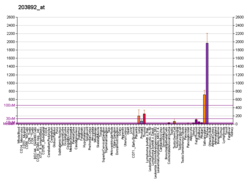| WFDC2 | |||||||||||||||||||||||||||||||||||||||||||||||||||
|---|---|---|---|---|---|---|---|---|---|---|---|---|---|---|---|---|---|---|---|---|---|---|---|---|---|---|---|---|---|---|---|---|---|---|---|---|---|---|---|---|---|---|---|---|---|---|---|---|---|---|---|
| Identifiers | |||||||||||||||||||||||||||||||||||||||||||||||||||
| Aliases | WFDC2 , EDDM4, HE4, WAP5, dJ461P17.6, WAP four-disulfide core domain 2 | ||||||||||||||||||||||||||||||||||||||||||||||||||
| External IDs | OMIM: 617548; MGI: 1914951; HomoloGene: 4450; GeneCards: WFDC2; OMA:WFDC2 - orthologs | ||||||||||||||||||||||||||||||||||||||||||||||||||
| |||||||||||||||||||||||||||||||||||||||||||||||||||
| |||||||||||||||||||||||||||||||||||||||||||||||||||
| |||||||||||||||||||||||||||||||||||||||||||||||||||
| |||||||||||||||||||||||||||||||||||||||||||||||||||
| |||||||||||||||||||||||||||||||||||||||||||||||||||
| Wikidata | |||||||||||||||||||||||||||||||||||||||||||||||||||
| |||||||||||||||||||||||||||||||||||||||||||||||||||
WAP four-disulfide core domain protein 2 - also known as Human Epididymis Protein 4 [5] (HE4) - is a protein that in humans is encoded by the WFDC2 gene. [6] [7] [8]
Contents
HE4 is a tumor marker of ovarian cancer, with 80% sensitivity at a cut-off of 150 pmol/L. [9]




